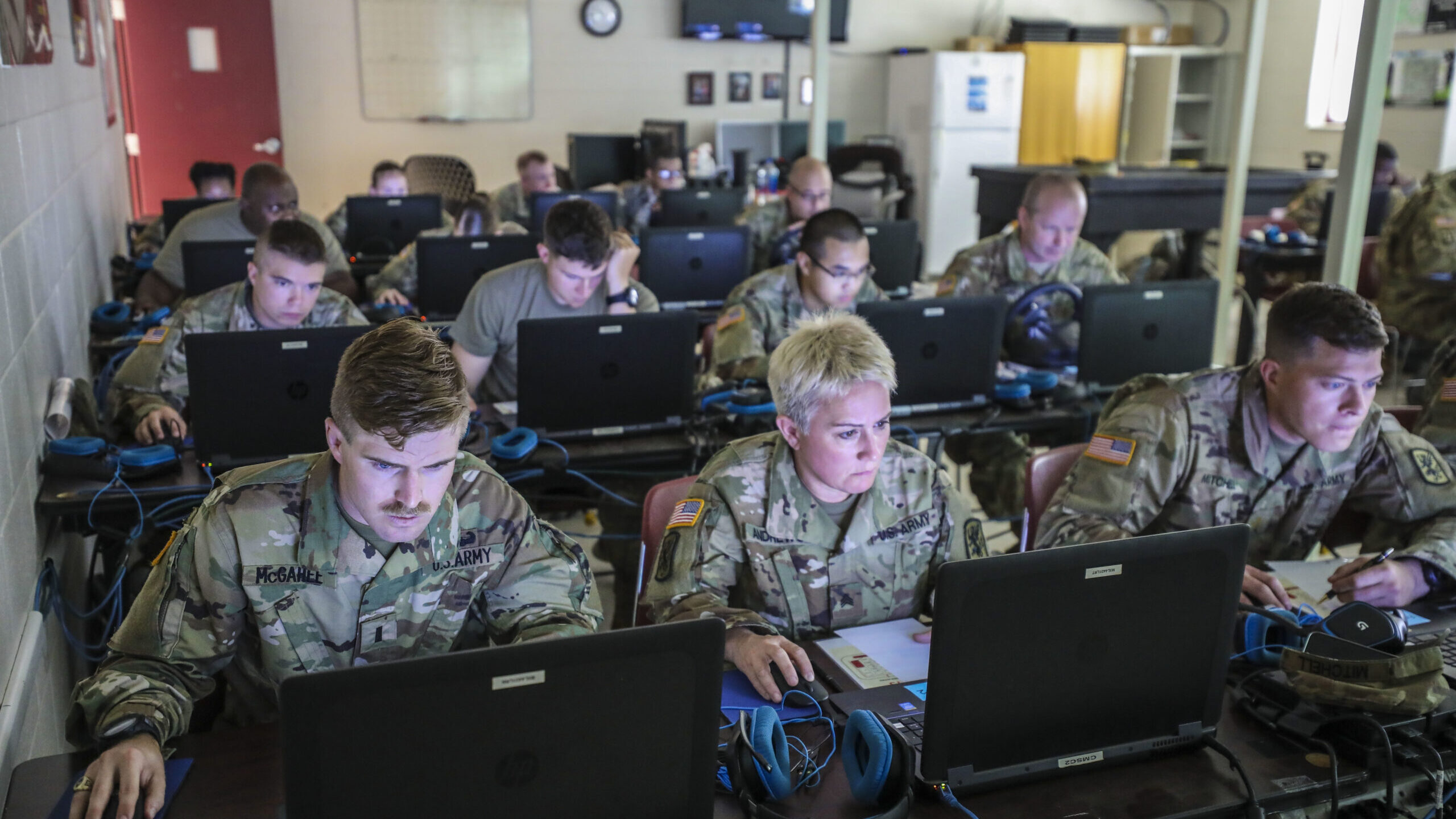
A group of Army Reserve Soldiers watch their computer monitors as they undergo virtual battlespace training (Official U.S. Army Reserve photo by Sgt. 1st Class Brent C. Powell via DVIDS)
AUSA: The Army is looking to create a unified cloud environment as a key piece of its new Army Digital Transformation Strategy (ADTS) aimed at centralizing its vast numbers of computer systems, data standards, cloud capabilities and cybersecurity procedures. And to that end, the service also is seeking to expand its use of non-traditional acquisition authorities, top officials explained today.
The strategy represents “a shift in terms of us starting to do things more at an enterprise, centralized level,” Raj Iyer, the Army’s chief information officer (CIO), told reporters in the margin of the annual Association of the United States Army (AUSA) trade show. “The Army in the past has always executed traditional IT in a very decentralized way — we let every command do their own thing. And that’s all led to a lot of silos of excellence over the years. Now, if you look at the requirements for multi-domain operations, that model doesn’t work anymore.”
RELATED: ‘Global By Nature’: Generals Say Unified Network Is ‘Operational Imperative’
The CIO office’s press to unify its “enterprise and tactical clouds” — and accelerate migration of data to that new cloud architecture in a standardized way — thus is a major focus of the ADTS.
“For cloud migration, it’s key that the office of CIO establishes the standards to do that migration,” stressed Brig. Gen. Matt Easley during the press roundtable. “We can’t allow every program office to go out and move to a cloud environment of their own their own design. We have to tell them the data standards we want them to use, the architecture standards, the cybersecurity standards on how we want them connected, and how to fuse that data to make that data usable and visible to the rest of the force.”
The service sees its multi-pronged $15 billion digital modernization effort as a top priority, the officials said, because it underpins the Army’s ability to plug and play into DoD’s Joint All Domain Command and Control (JADC2) strategy. Markowitz said the service has been working closely with the Joint Staff’s J6 directorate for Command, Control, Communications, & Computers/Cyber, Lt. Gen. Dennis Crall. In particular, this involves using contingency operations, such as the Afghanistan evacuation, and exercises, including Project Convergence, designed to figure out how to share Army information and data with the Combatant Commands, he said.
RELATED: DISA Head: DoD Working To Modernize ICAM, C2, Data Use
“We’re trying to experiment in real time with ongoing operations or exercises, kind of building a data foundation for a Combatant Command level, and for the Army’s interest we really want to make sure that data structure of how information flows is common across all Combatant Commands,” he said.
Mixing ‘Colors Of Money’
Iyer said that the ADTS also represents a shift in how the service works to encourage innovation and bring in industry partners, he said, including changing its acquisition approach.
While the Army, like all the services, faces challenges due to resource constraints, with his $15 billion annual budget, Iyer said, “money is not the problem” in implementing the digital transformation. It does mean having to divest its multiple individual data centers to invest instead in creating “one cloud.” A bigger issue is figuring out how to reform how the Army approaches budgeting.
Iyer said he has been talking with congressional staffers about how the Army can have more flexibility in the Planning, Programming, Budgeting and Execution (PPBE) process, and in how it funds digitization and cybersecurity across “colors of money” — that is, separate budget pots for research and development, procurement and operations and maintenance.
“We are absolutely in favor of some reform, especially when it comes to how we budget for digital, and then cyber quite frankly, because our cyber threats are changing and evolving all the time. The way the PPBE process works is that you plan for something five years in advance, and then you program for it, and then you wait and five years later you get the money to execute. But we know how fast technology changes, we know how fast the the threats in the cyberspace are changing. And so, it’s a question about the flexibility the process to be able to do things.”
And while Congress has given the Defense Department more ability to use non-traditional acquisition tools, such as Broad Agency Announcements and Other Transaction Authorities, the Army up to now has been a bit cautious on how it applied them to software development, digitization and cybersecurity, David Markowitz, the service’s chief data officer, said during the roundtable.
“I’m not sure we’ve used the pilot authorities to the extent folks in Congress wanted us to. We’re a little slower than the Air Force, they’re a little more aggressive on these,” he said.
That’s in part because service leaders are still struggling a bit to understand exactly what is going on internally with investments.
“We have to do the internal work. Let’s be honest, we have difficulty seeing across the large scope of the Army how money is being spent in the digital area, and particularly on cyber security,” he added.






















